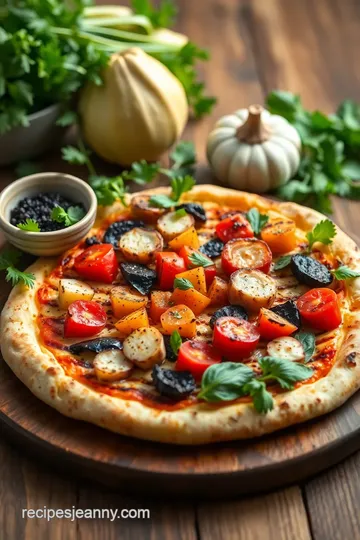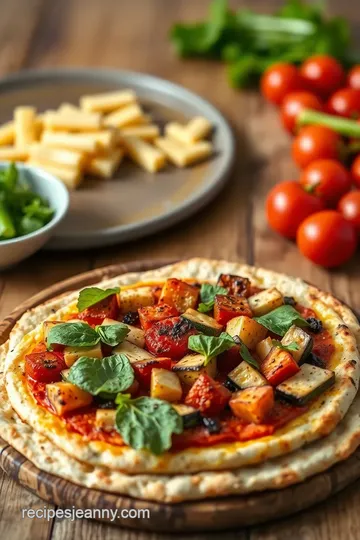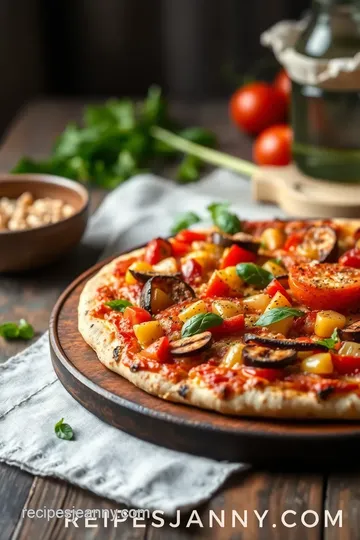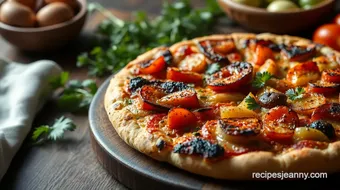Grilled Veggie Pizza with Tasty Vegetables
Craving the best Grilled Veggie Pizza with Tasty Vegetables? My simple recipe brings fresh, smoky flavors to your table! Perfect for any gathering.

- look into into a Flavor Explosion: Grilled Veggie Pizza with Tasty Vegetables!
- Essential Ingredients Guide: Unlocking the Secrets to Delicious Pizza
- Professional Cooking Method: Grilling Up Flavorful Perfection!
- Pro Tips & Secrets for Your Grilled Veggie Pizza
- Perfect Presentation: Make Your Pizza Instagram-Worthy
- Storage & Make-Ahead Tips
- Creative Variations
- Complete Nutrition Guide
- Frequently Asked Questions
- Recipe Card
look into into a Flavor Explosion: Grilled Veggie Pizza with Tasty Vegetables!
Oh my gosh, have you ever had that feeling when you bite into a pizza and it’s like an explosion of flavors? that’s exactly what happened to me the first time i tried a grilled veggie pizza with tasty vegetables .
I mean, who knew grilling veggies could make such a difference? it was one of those hot summer nights, the kind that just screams for something fresh and light.
Well, let me tell you, this pizza hit the spot!
A Slice of History
Now, let’s rewind a bit. pizza has its roots in italy, but we all know that america has put its own spin on things.
The beauty of this grilled pizza recipe ? it marries that classic pizza experience with the charm of rustic outdoor cooking.
Grilling brings out a smokiness that’s just irresistible. these days, grilled veggie recipes have become super popular—especially during backyard barbecues where families gather to celebrate the joys of summer.
What to Expect
Okay, so how long are we talking about making this masterpiece? you’re looking at around 75 minutes total time — 30 minutes to prep the dough, 30 for it to relax, and just about 15-20 to cook.
It’s a medium difficulty level, but trust me, once you nail that homemade pizza crust, you’ll feel like a kitchen rock star.
This recipe isn’t just about satisfying your hunger; it’s also budget-friendly. you can whip up a grilled pizza for about $15 , depending on what veggies you choose.
And hey, it serves four people, so everybody can enjoy a slice of happiness.
Why You’ll Love It
Let’s talk benefits. first off, this pizza is packed with healthy pizza options —fresh vegetables loaded with nutrients. we’re talking bell peppers, zucchini, and juicy cherry tomatoes.
It’s a great way to sneak in those veggies, especially if you’re making it for the kiddos. also, by grilling those veggies, we’re enhancing their flavor.
Those charred bits? pure magic.
And if you’re into special occasions, this pizza is a total crowd-pleaser. birthdays, family get-togethers, or even just a cozy night with friends, it’s perfect! plus, guess what? you can totally toss in creative pizza flavors by mixing and matching your favorite vegetable toppings for pizza .
Not Your Average Pizza
Unlike the typical takeout options, grilling gives this pizza a unique edge. the crust gets that perfect crunch, while the smoky grilled vegetable toppings elevate it to a gourmet level.
You can even explore mediterranean pizza variations —think olives and artichokes next time!
So, if you’re ready to grab those seasonal veggies and fire up the grill, stay tuned! let's dive into the ingredients you'll need to craft this delicious charred vegetables pizza that's not just about filling you up, but leaving you with a smile.
Up next, I’ll share the ingredient list that'll get your taste buds dancing. Trust me, you’ll want to keep this recipe as a go-to family-friendly dinner recipe !

Essential Ingredients Guide: Unlocking the Secrets to Delicious Pizza
Oh my gosh, let’s talk about the magic behind a grilled veggie pizza with tasty vegetables ! we all know that the right ingredients can make or break your pizza night.
So, grab a comfy seat because i’m about to fill you in on some essentials that will have your friends raving!
Premium Core Components
First off, let’s get into the premium core components . You gotta have the good stuff, right? Here’s a quick breakdown:
- All-purpose flour : For that perfect homemade pizza crust. You’ll need about 2 cups (240g) . Aim for that good quality flour; it’ll make your crust rise beautifully.
- Instant yeast : One packet, or 2 ¼ teaspoons (7g) will do the trick. Make sure it’s fresh, or it’ll flop!
- Warm water : About ¾ cup (180ml) , around 110° F ( 43° C) is ideal. Not too hot or you'll kill the yeast.
- Olive oil : A tablespoon of this liquid gold adds flavor and moisture.
Storage? flour and yeast can chill in your pantry, while olive oil should be kept in a cool, dark place.
When it comes to freshness, look for the best-by dates on yeast—this stuff is finicky!
Signature Seasoning Blend
Now, let’s talk about your signature seasoning blend . Flavor is everything!
- Essential spice combinations : Salt and pepper are your best friends. They enhance everything you throw on that pizza.
- Herb selections : Fresh basil is a must, but don’t forget about oregano; it brings that classic pizza vibe.
- Explore : Want something spicy? Toss in some red pepper flakes for that kick!
Regional variations? Oh, there are so many! Think Mediterranean vibes with olives, or go for a spicy Southwest twist with chipotle seasoning!
Smart Substitutions
Alright, life happens, and you might not have everything on hand. Here are some smart substitutions :
- Zucchini lovers, fear not ! Swap it out for eggplant or mushrooms .
- Dietary modifications ? Go for gluten-free flour for the crust.
- You could be out of mozzarella, but don’t worry— cheddar works wonders too!
- If you need an emergency replacement for bell peppers, try some sliced tomatoes instead.
These alternatives can keep your pizza game strong no matter the season!
Kitchen Equipment Essentials
Let’s tackle the kitchen equipment essentials . You don’t need a fancy setup; just a few must-have tools will do:
- Mixing bowls and a rolling pin : Basic, but essential. You need a large bowl for mixing dough and a rolling pin for flattening it out.
- Grill or grill pan : To get that smoky grilled pizza flavor going. Trust me; it’ll change your pizza game!
I recommend investing in a pizza stone . It helps achieve that crispy crust we all love.
Oh, and don’t forget your kitchen thermometer ! This little gadget is a game-changer when making sure your water is at the right temp.
Bringing It All Together
So here’s the deal: with the right ingredients, seasoning, and equipment, you’re ready to dive into creating the perfect Grilled Veggie Pizza that will have everyone coming back for seconds.
If you’re feeling adventurous—mix and match your toppings! get those bell peppers, zucchini, and cherry tomatoes dancing on that crust.
And remember, cooking with seasonal vegetables will elevate your dish from average to extraordinary.
Next up, i’ll run you through the step-by-step instructions to bring your delicious pizza dream to life! whether it’s family-friendly dinner recipes or quick summer meals, you’ll be serving slices of love in no time.
Let’s start grilling!

Professional Cooking Method: Grilling Up Flavorful Perfection!
When it comes to cooking, there's a world of difference between just throwing a pizza together and crafting a mouthwatering masterpiece like a grilled veggie pizza with tasty vegetables .
Let’s chat about how to elevate your pizza game through essential preparation steps, a step-by-step process, expert techniques, and some success strategies that will make you the star of the barbecue this summer!
Essential Preparation Steps
First things first: let’s discuss mise en place . this fancy french term basically means “everything in its place.” before you even touch that dough, chop your veggies — bell peppers, zucchini, and cherry tomatoes, oh my! get them all ready, tossed in olive oil, salt, and pepper.
Prepping makes everything smoother and quells the chaos.
Now, onto time management tips . aim to break down your tasks. get your dough going, let it rise, and while you wait, grill up those veggies.
It’s all about multitasking. if you’re waiting around, you might as well be doing something productive.
Organization is key , too. Keep your ingredients laid out where you can see them. That way, you won’t be rummaging through your pantry at the last second, wondering where the oregano went!
And don’t forget about safety considerations ! when grilling, it’s hot out there. always have a pair of tongs handy and avoid cross-contamination by using separate cutting boards for veggies and raw meats—if you’re using any.
Safety first, friends!
Step-by-Step Process
Ready to dive in? Let’s break down the cooking process into simple directions you can follow easily.
-
Make the dough : in a mixing bowl, combine 2 cups of flour , 1 packet of instant yeast , and ¾ teaspoon salt .
Gradually blend in ¾ cup of warm water (make sure it’s about 110° f ) and 1 tablespoon of olive oil .
Knead until the dough feels elastic and smooth.
-
Let it Rise : Cover the dough and let it rest for 30 minutes . This is when the yeast works its magic.
-
Grill those veggies : preheat your grill to medium-high (around 400° f ). toss those colorful veggies in your prepared olive oil mixture and grill for 5- 7 minutes , until they’re tender and slightly charred.
-
Roll Out the Dough : After your dough has risen, punch it down and roll it out to about ¼ inch thick on a floured surface.
-
Assemble the Pizza : Transfer the dough to a preheated pizza stone or baking sheet. Layer it with your grilled veggies and sprinkle 1 cup of mozzarella cheese on top.
-
Grill the pizza : pop the pizza on the grill, close the lid, and let it cook for 8- 10 minutes .
You’ll know it’s done when the crust is golden. (a kitchen thermometer is great to have here – a final crust temperature of 190° f is ideal).
Expert Techniques
Let’s get a little fancier with those expert techniques. for starters, using a pizza stone is a game changer. it helps achieve that crispy crust you're dreaming of.
If you don’t have one, a preheated baking sheet does the trick, too.
Next, let’s chat about some quality checkpoints . keep an eye on your grilled veggies; you want them tender but not mushy.
And as for that pizza? if the cheese is bubbly and slightly browned, you are hitting a home run.
Troubleshooting tips : If your dough is too sticky, just sprinkle a bit of flour. For soggy pizza, avoid overloading on those yummy toppings; balance is everything!
Success Strategies
Now, let’s make sure you avoid those common mistakes. for one, don’t overload your pizza with toppings! too much can lead to the dreaded sogginess.
You want your crust to shine with those fresh flavors.
Always do a quick quality assurance check before serving. Taste the sauce, adjust seasonings, and make sure everything is fresh!
Looking for a make-ahead option ? You can totally prep your dough a day in advance and keep it in the fridge. Let it warm up a bit before rolling it out.
In closing, whether you’re looking for quick summer meals or planning a family-friendly dinner, this grilled veggie pizza with tasty vegetables is just the ticket.
Each slice is a celebration of summer and a superb way to enjoy those fresh, seasonal veggies!
And now, if you're hungry for more, let’s dive into some additional information to really up your pizza-making skills!

Pro Tips & Secrets for Your Grilled Veggie Pizza
Alright, first things first! Making a Grilled Veggie Pizza with Tasty Vegetables is like an adventure in flavors. Here are some personal tips I've picked up along the way.
Chef’s Personal Insights
One of my favorite secrets? always use fresh, seasonal vegetables ! seriously, the difference is night and day. whether it’s juicy cherry tomatoes or colorful bell peppers, fresh picks add so much more flavor.
The way those veggies get all nice and charred while grilling? no wonder this is one of my go-to summer vegetable recipes !
Time-Saving Techniques
Got a busy schedule? no worries! you can prep the homemade pizza crust a day ahead. just make your dough, let it rise, and pop it in the fridge.
When you're ready to grill, just take it out, roll it out, and top it like a champ.
Flavor Enhancement Tips
Don’t skimp on seasoning! before grilling your veggies, toss them with olive oil and a splash of balsamic—oh my gosh, it elevates the taste! you might even want to sprinkle some garlic powder for an extra kick.
Trust me, you’ll want to make this a staple in your easy pizza recipes rotation.
Presentation Advice
Plating is everything! When serving your pizza, slice it into neat pieces and sprinkle fresh basil over the top. It adds that pop of color and visual appeal that makes everyone go, “Wow!” Plus, who doesn’t love a good garnish?
Perfect Presentation: Make Your Pizza Instagram-Worthy
Now that we got the secrets out of the way, let’s talk looks. A pizza isn’t just about taste; it’s gotta be pretty too!
Plating Techniques
When you slide your pizza onto a cutting board, slice it in a star pattern. not only does it look cool, but it also makes it easier to share.
And you definitely want to share this beauty!
Garnish Ideas
For garnish, fresh basil is your best friend. But you could also try a sprinkle of arugula for a peppery note. Trust me, your guests will think you’re a gourmet chef!
Color Combinations
Don’t be afraid to mix and match with colors. bright yellows, vibrant reds, and deep greens create a stunning visual.
Use purple onions for contrast, and cherry tomatoes add a pop of red that draws the eye.
Visual Appeal Tips
Remember, you eat with your eyes first! arrange those grilled vegetable toppings artfully before serving. even a light drizzle of good balsamic vinegar can make your pizza look like a work of art.
Storage & Make-Ahead Tips
Now, if you’re like me and always cooking extra, here’s how to keep that pizza fresh.
Storage Guidelines
If there’s any leftover pizza (which I doubt because it’s so darn good), store it in an airtight container in the fridge. It’ll stay fresh for about 3-4 days.
Preservation Methods
For long-term storage, wrap individual slices in foil and pop them in the freezer. They’ll last about 2-3 months. Just reheat when you need a quick meal—hello, quick summer meals !
Reheating Instructions
To reheat, pop it on a pan over medium heat for about 5- 8 minutes. You’ll regain that crispy crust without the microwave sogginess!
Freshness Duration
Homemade food, especially pizza, is best enjoyed fresh. The fresher, the better! But don’t sweat if you have leftovers—just enjoy them the next day!
Creative Variations
Once you master the basics, you can get totally creative with your Grilled Veggie Pizza!
Flavor Adaptations
Love heat? Toss in some jalapeños or try a spicy Mediterranean pizza variation . Just imagine grilled olives and feta—dreamy!
Dietary Modifications
Have vegan friends? No problem! Swap mozzarella for a vegan cheese alternative and still enjoy that grilled goodness. Who said good pizza couldn’t be healthy pizza options ?
Seasonal Twists
Use whatever's in season. In summer, fresh basil and tomatoes shine. In fall, roasted butternut squash would be epic . Change it up with the seasons to keep things exciting.
Regional Variations
Feeling adventurous? Try adding barbecue sauce as a base for a smoky twist. It turns a classic pizza into a unique treat.
Complete Nutrition Guide
Last but not least, you’ve got to know what’s in your food!
Detailed Breakdown
A slice of this pizza is packed with wholesome ingredients. Each serving gives you about 300 calories , which means you can enjoy it guilt-free.
Health Benefits
Thanks to the healthy pizza options and loads of veggies, your body gets a nice dose of vitamins and fiber. Plus, those grilled veggies make for better digestion. Yay!
Dietary Considerations
This pizza recipe is a delightful balance of carbs and veggies, making it suitable for a myriad of dietary plans. Want gluten-free? Just swap the crust!
Portion Guidance
Tomato and veggie lovers, rejoice! Feel free to give in to a generous slice (or two) because, after all, it’s all about balance, right?
So there you have it! You’re all set to conquer the world of pizza-making. Enjoy your Grilled Veggie Pizza with Tasty Vegetables and make those summer nights even better. Happy grilling!
Frequently Asked Questions
What vegetables work best for Grilled Veggie Pizza with Tasty Vegetables?
For the best flavor and texture, opt for colorful vegetables like bell peppers, zucchini, and red onions. You can also add cherry tomatoes for sweetness. Feel free to experiment with seasonal veggies like eggplant, mushrooms, or even spinach!
Can I make the dough for Grilled Veggie Pizza ahead of time?
Absolutely! You can prepare the dough and let it rest for up to 2 hours at room temperature or refrigerate it for up to 24 hours. You can also freeze the dough for longer storage; just make sure to thaw it in the refrigerator overnight before using it.
How do I store leftover Grilled Veggie Pizza with Tasty Vegetables?
Store leftover pizza in an airtight container in the refrigerator for up to 3 days. To reheat, place slices in a preheated oven or grill to maintain the crust's crispness, instead of using a microwave, which can make the pizza soggy.
Can I use a different type of cheese on my Grilled Veggie Pizza?
Yes, you can definitely swap mozzarella with your favorite cheese! Cheeses like provolone, goat cheese, or feta can add unique flavors. Mixing different cheeses can also enhance the overall taste profile of your pizza.
What are some tips for achieving a crispy crust on my grilled pizza?
To achieve a crispy crust, use a preheated pizza stone or grill pan and ensure the grill temperature is high before placing the pizza on it. Also, make sure not to overload the toppings, as too many can make the crust soggy.
Are there any nutritional benefits to Grilled Veggie Pizza with Tasty Vegetables?
Yes! This pizza is packed with nutritious vegetables, providing essential vitamins, minerals, and fiber. The use of olive oil also contributes healthy fats, making it a wholesome option compared to traditional pizzas loaded with processed toppings.
Grilled Veggie Pizza with Tasty Vegetables Card

⚖️ Ingredients:
- 2 cups all-purpose flour
- 1 packet instant yeast
- ¾ teaspoon salt
- ¾ cup warm water
- 1 tablespoon olive oil
- 1 cup assorted bell peppers, sliced
- 1 cup zucchini, sliced
- 1 cup cherry tomatoes, halved
- ½ cup red onion, thinly sliced
- 1 cup mozzarella cheese, shredded
- 2 tablespoons olive oil
- Salt and pepper to taste
- 1 teaspoon dried oregano
- Fresh basil for garnish
🥄 Instructions:
- Step 1: In a bowl, combine flour, yeast, and salt.
- Step 2: Gradually mix in warm water and olive oil.
- Step 3: Knead the dough on a floured surface until elastic.
- Step 4: Cover and let it rest for 30 minutes.
- Step 5: Preheat the grill to medium-high.
- Step 6: Toss bell peppers, zucchini, cherry tomatoes, and red onion in olive oil, salt, pepper, and oregano.
- Step 7: Grill veggies for 5-7 minutes until tender and slightly charred. Set aside.
- Step 8: Punch down the rested dough and roll it out on a floured surface to your desired thickness.
- Step 9: Transfer the dough to a preheated pizza stone or baking sheet.
- Step 10: Spread grilled veggies evenly over the crust.
- Step 11: Sprinkle shredded mozzarella cheese on top.
- Step 12: Place the pizza on the grill and close the lid.
- Step 13: Grill for 8-10 minutes or until the crust is golden and the cheese is bubbly.
- Step 14: Remove pizza from the grill and let it cool for a couple of minutes.
- Step 15: Garnish with fresh basil, slice, and serve.
Previous Recipe: Easy Bake Brown Sugar Cinnamon Shortbread Treats: A Melt-in-Your-Mouth Delight
Next Recipe: Indulgent Churned Coconut Milk Coffee Ice Cream Delight: A Tropical Treat
